
Sardine and pilchard are common names for various species of small, oily forage fish in the herring family Clupeidae. The term 'sardine' was first used in English during the early 15th century; a somewhat dubious folk etymology says it comes from the Italian island of Sardinia, around which sardines were once supposedly abundant.

Hakea is a genus of about 150 species of plants in the Family Proteaceae, endemic to Australia. They are shrubs or small trees with leaves that are sometimes flat, otherwise circular in cross section in which case they are sometimes divided. The flowers are usually arranged in groups in leaf axils and resemble those of other genera, especially Grevillea. Hakeas have woody fruit which distinguishes them from grevilleas which have non-woody fruit which release the seeds as they mature. Hakeas are found in every state of Australia with the highest species diversity being found in the south west of Western Australia.

The goldstripe sardinella is a species of fish of the family Clupeidae. It is native to shallow tropical waters of the western Indo-Pacific, living at depths down to 70 m, and being associated with coral reefs. It grows up to 17 cm in length and forms large schools.
Shorea gibbosa is a large emergent rainforest tree species in the family Dipterocarpaceae. It is native to Sumatra, Borneo, Peninsular Malaysia and Singapore. The tallest measured specimen is 81.1 metres tall, in the Tawau Hills National Park, in Sabah on the island of Borneo.
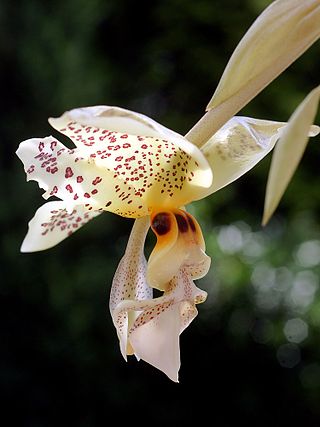
Stanhopea gibbosa is a species of orchids from Colombia and West Ecuador. The name was often misapplied for a species from Costa Rica and Panama which was later described as Stanhopea confusa. Stanhopea carchiensis and Stanhopea impressa are synonyms of Stanhopea gibbosa.
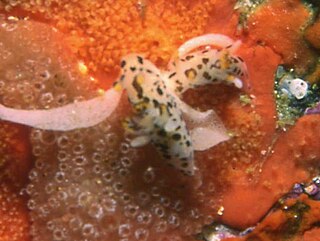
Ancula is a genus of sea slugs, specifically dorid nudibranchs, marine gastropod molluscs in the family Goniodorididae.

Ancula gibbosa, common name Atlantic ancula, is a species of dorid nudibranch. It is a marine gastropod mollusc in the family Goniodorididae.
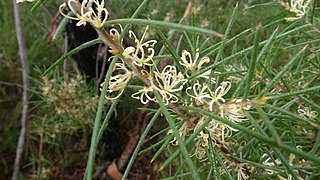
Hakea gibbosa, commonly known as hairy hakea or needlebush hakea, is a shrub of the family Proteaceae, and is endemic to south eastern Australia. It has very prickly foliage, cream-yellowish flowers from April to July, and provides shelter for small birds. It has become an environmental weed in South Africa and New Zealand, where it had been introduced for use as a hedge plant.
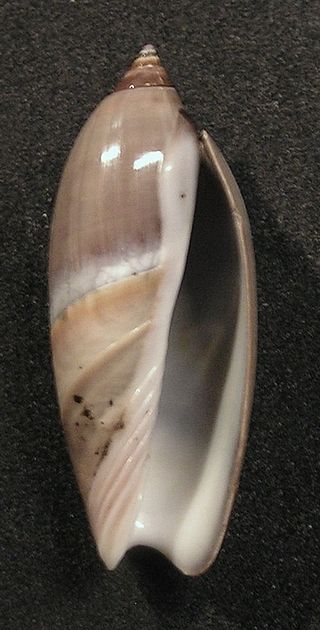
Agaronia is a genus of sea snails, marine gastropod mollusks in the family Olividae.

Plicatula is a genus of saltwater clams, marine bivalve molluscs, known commonly as kitten's paws or kittenpaws in the family Plicatulidae.
Tilesina is a monospecific genus of ray-finned fish belonging to the subfamily Brachyopsinae in the family Agonidae. Its only species is Tilesina gibbosa, a species found in the northwestern Pacific Ocean. This species occurs at depths of from 15 to 400 metres. This species grows to a length of 36 centimetres (14 in) TL.
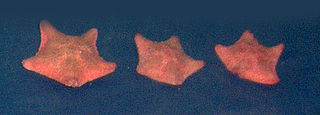
Asterina gibbosa, commonly known as the starlet cushion star, is a species of starfish in the family Asterinidae. It is native to the northeastern Atlantic Ocean and the Mediterranean Sea.
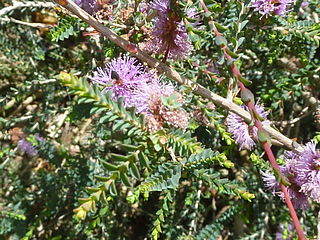
Melaleuca gibbosa, commonly known as the slender honey-myrtle or small-leaved honey-myrtle is a plant in the myrtle family, Myrtaceae and is endemic to southern Australia. It is a dense, bushy shrub to about 2 metres (6.6 ft) with numerous slender, arching branches and oblong heads of mauve flower spikes in spring and sparsely throughout the year.

Fritillaria gibbosa is a species of herbaceous perennial plant in the lily family Liliaceae. It is native to Afghanistan, Iran, Pakistan, Turkmenistan, and Transcaucasia.

Pterostylis gibbosa, commonly known as the Illawarra rustyhood, or Illawarra greenhood, is a plant in the orchid family Orchidaceae and is endemic to New South Wales. It has a rosette of leaves at its base and up to nine bright green flowers with translucent "windows", relatively wide lateral sepals with short-pointed tips and a dark, fleshy, insect-like labellum.

Goodenia gibbosa is a species of flowering plant in the family Goodeniaceae and is endemic to central Australia. It is a prostrate to low-lying, often stoloniferous herb covered with soft hairs. It has elliptic to lance-shaped leaves and small groups of yellow flowers.

Laphria gibbosa is a species of fly belonging to the family Asilidae.

Psococerastis is a genus of insects belonging to the family Psocidae.

The humpbacked scorpionfish is a species of venomous marine ray-finned fish belonging to the family Scorpaenidae, the scorpionfishes. This species is found in the western Indian Ocean.

Phalaenopsis thailandica is a species of orchid native to Thailand. It was described by Olaf Gruss and Jürgen Roeth, after differences from the type description were noticed in cultivated plants labeled as Phalaenopsis gibbosa. The specific epithet thailandica refers to this species native range in Thailand.


















